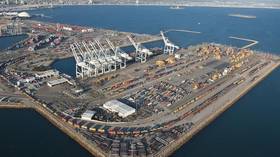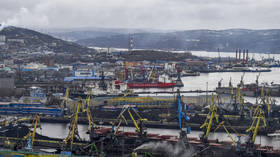Oil is thicker than water: What to expect from Putin-Modi trade talks

Against a backdrop of intricate geopolitical dynamics, India’s unwavering commitment to strong ties with Russia has become evident during Indian Prime Minister's Narendra Modi visit to Moscow. Despite Western pressure, New Delhi has consistently nurtured economic and defense partnerships with Moscow, with a particular focus on the oil sector in the recent past.
India boldly continued purchasing discounted Russian crude oil after the Ukraine conflict escalated in 2022, despite open criticism from New Delhi’s Western partners. This has contributed significantly to increasing their bilateral trade. During the fiscal year 2023-24 (FY24), bilateral trade reached an all-time high of $65.7 billion, largely attributed to imports of crude oil, coal, and fertilizers. This represents a substantial 33% increase compared to the previous year, underscoring the resilience and strength of the India-Russia partnership. This is also double the $30 billion target earlier set by the two leaders to be achieved in bilateral trade by 2025.
In June, Indian refiners achieved record imports of Russia’s Urals crude grade, totaling 2.13 million barrels per day (mb/d), the highest since the previous year’s peak, overtaking Saudi Arabia and Iraq.
India’s strategic reliance on Russian oil not only impacts imports but also influences its exports. Cheaper crude oil from Russia has facilitated India’s value-added petroleum product exports, contributing to a 54.78% increase in exports of petroleum products during April-January FY23. Countries such as Brazil, Israel, the Netherlands, and South Africa have witnessed substantial growth in Indian exports, with petroleum products playing a crucial role.
Crude reality: Why has India ramped up imports of Russian oil?
As New Delhi ramps up its oil imports from Russia, a key driver of enhanced bilateral trade, India could be negotiating for higher oil discounts, potentially surpassing the current rate of $3 to $3.5 per barrel during Modi’s visit, as suggested by certain sources.
According to India’s state-owned Bharat Petroleum Corporation (BPCL), Russian crude oil discounts have almost halved to $3-6 per barrel at present from an average of $8-10 during FY24. The reduction in discounts was mainly due to higher freight and insurance expenses for delivery from the Baltic and Black Sea to the west coast.
ICRA rating agency suggested that India saved approximately $5.1 billion on its oil import bill in 2023 fiscal and $7.9 billion in the first 11 months of 2024 fiscal due to discounts on Russian cargoes. “With India’s oil import dependency expected to remain high, if the discounts on purchases of Russian crude persist at the prevailing low levels, ICRA expects India’s net oil import bill to widen to $101-104 billion in FY25 from $96.1 billion in FY24, assuming an average crude oil price of $85 per barrel in the fiscal.”
It is difficult to pinpoint an exact threshold of the price level for India to import oil from other countries. However, if the discounted crude continues to shrink further at the levels where its import bills could start surging beyond sustainable levels and that too for a longer period of time, as noted by ICRA in the previous response, India could look into importing crude oil from other countries.
Trade asymmetry
Despite robust bilateral trade, largely owing to increased oil imports, India’s exports to Russia in FY24 amount to approximately $4.26 billion, a situation that has left India dissatisfied due to the trade imbalance. According to the Ministry of Commerce and Industry, in the 2023-24 financial year, New Delhi’s trade deficit with Moscow surged by 33%, reaching over $57 billion, which is eight-fold since 2021-22. This widening deficit underscores the economic dynamics between the two nations and highlights the importance of managing trade imbalances effectively.
According to Indian Ambassador to Russia Vinay Kumar, “Balancing trade is a key priority for the two countries to sustain the growth momentum.” He said, “We need to deal with market access issues, [explore] new opportunities for Indian goods in the Russian market, this includes agricultural products, processes food, automobile parts, and other items.”
Hard to port: India defies Washington’s pressure to deal with Iran
India has expanded its exports to Russia, covering a range of products such as pharmaceuticals, organic chemicals, electrical machinery, mechanical appliances, and iron and steel. Additionally, textiles and even electric cars may find their way into the export basket in the future.
However, Russia’s deputy minister of economic development, Vladimir Ilyichev, noted that “a further balancing of bilateral trade will be possible after India and the Eurasian Economic Union (EEU)” conclude a free trade agreement (FTA). India is expected to commence negotiations for a FTA with the Russia-led Eurasian Economic Union, which also includes Armenia, Belarus, Kazakhstan, and Kyrgyzstan.
India should carefully consider the necessary steps to tackle the growing trade imbalances, especially in the context of bilateral engagements. Balancing trade priorities and exploring new opportunities for Indian goods in the Russian market besides India’s FTA with the EEU are crucial steps to address trade asymmetry.
Expanding clean energy portfolio
In a joint statement during Prime Minister Modi’s visit to Vladivostok in September 2019, India and Russia expressed their intent to explore opportunities for expanding cooperation in various energy domains. These include hydro and thermal power, energy efficiency, and the development of facilities that harness energy from non-conventional sources.
For instance, in February 2020, India’s Bureau of Energy Efficiency and Russia’s Energy Agency signed an MoU to boost energy efficiency. The collaboration involves energy audits, international events, and a roadmap covering topics like energy sector efficiency, CCS, and hydrogen.
On the nuclear energy front, during his visit to India earlier this year, Rosatom Director General Aleksey Likhachev signed a protocol to expedite the construction of Kudankulam nuclear power plant units 3-6, aligning with India’s plan to increase nuclear capacity from 7,480 MWe to 22,800 MWe by 2031-32.
This new trade route could revolutionize Russia-India trade and strategic partnership
Additionally, Russia offered India its RITM-200 Small Modular Reactor technology, capable of generating up to 350 MW. This compact, modular design could accelerate construction compared to traditional plants, aiding India’s energy goals. Evaluating feasibility, safety, and geopolitical implications is crucial, emphasizing the need for careful risk assessment. These initiatives may feature in discussions during Modi’s Moscow visit to advance these projects.
Activating Eastern Maritime Corridor Route
India and Russia are exploring greater investments in the Eastern Maritime Corridor (EMC) and Siberia. India seeks to procure minerals from Russia. However, challenges such as insurance arrangements and negotiations with intermediary ports remain.
The EMC is a proposed sea route connecting the Indian port of Chennai to the Russian port of Vladivostok. It aims to facilitate trade in coking coal, crude oil, LNG, fertilizers, and containers. Once completed, the EMC will reduce transportation time from over 40 days to just 24 days, providing India with a shorter and more efficient route to access markets in the Far East, including China and Japan.
In June, Russia announced a new shipping route to export coal to India using INSTC, at the St. Petersburg International Economic Forum. This would cut the transit time from 45 days to 15 days, making Russian crude more competitive than its counterparts. Russia’s coal exports to India have decreased this year compared to last year, mainly because of higher freight rates and competition from India’s established suppliers such as Australia and Indonesia, Therefore, any discussions on activating trade routes, including INSTC and the Chennai-Vladivostok maritime route, would prove beneficial for coal trade moving forward.
Prime Minister Modi’s visit to Moscow underscores India’s steadfast commitment to enhancing its multifaceted relationship with Russia. As both nations navigate complex global dynamics, the Moscow talks are poised to chart a course for deeper collaboration across all strategic sectors, reaffirming the enduring strength of the partnership between the two nations.

















Add new comment